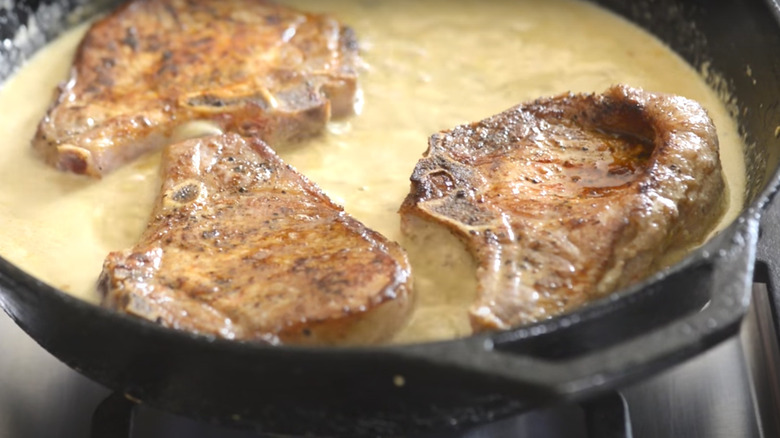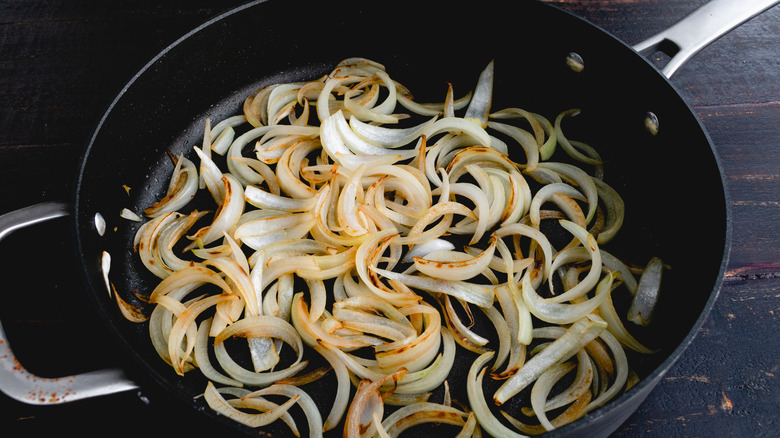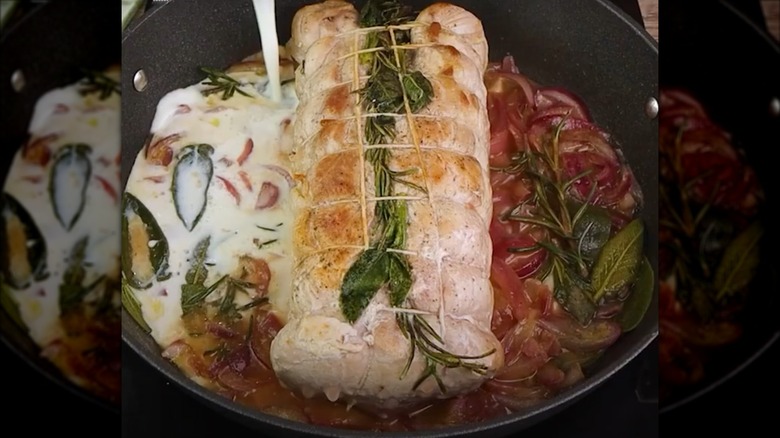Is Milk Really The Secret To Tender Braised Pork?
The shoulder and the Boston butt, left to their own devices, are tough to cut and tough to chew. And while making a batch of sausage with them certainly counts among the options you have to make these cuts of pork easier to eat, they aren't the only ones, nor should they be. Instead, you should apply, shall one say, a bottle intervention to the toughness problem. More plainly, if you braise your pork in milk, you won't have to resort to making sausage.
This method of braising pork, whether it's boneless pork chops, tenderloin, or something else, is a classic technique right out of the Italian cooking playbook. Thanks to the lactic acid in milk, the tough, sinewy parts of these and other tough pork cuts break down. Milk-braised pork goes from burly to brilliant in two to four hours.
Some home gourmands opt to braise their meat in stock or wine instead of milk because they're afraid that the milk will curdle. This does happen. However, the curdles are small. More importantly, they form the building blocks of a tasty sauce, so a little curdling is good in this case.
Aside from the complexities of taste that the pork draws in from the seasonings you cook in with it, it also gets a flavor boost from the Maillard process. In other words, braised pork gets both a good searing and a good dunking — two great cooking methods swirling together in one pot. How bad could that be?
Seasoning the meat
To give the pork the best shot at not developing "muddy" flavors, start the braising process with a more neutral oil like vegetable oil. This goes in a Dutch oven or a skillet — any pot or pan with a heavy bottom — that you'll set to medium-high. This offers meat the best chance to sear evenly. You'll know the searing portion of this job is done when the pork takes on the color of a lightly-colored nut. When it's done, set it aside. It'll come back into play a bit later.
Creating a layered flavor profile comes next. The leftover meat drippings in the pan become the basis for this. Chop up onions, leeks, or garlic and allow them to sweat in the pan. If you're not quite ready for the milk yet, then this is the point where you'll turn this into a flavor symphony by sprinkling some herbs and spices into the pan. From a taste perspective, you can't go wrong with herbs like oregano, thyme, or rosemary. Mushrooms and celery bring more umami to the dish. Finally, the addition of a vegetable like carrots makes this savory dish the right kind of sweet.
Cooking the pork in milk
Braising isn't boiling, which means the whole roast or tenderloin won't be basking in a neck-deep tub of milk, in a manner of speaking. Instead, the upper portions of the meat should stay clear of the milk. As for the milk itself, whole milk typically works best in this scenario. This is the Goldilocks solution here. Whole milk doesn't soak the pork in oily fat like cream would. And it has more fat than skim, leaving you with a thick, creamy gravy once the meat is done cooking. In other words, milk is just right for this.
Additionally, when you sear meat like this, you'll leave a crust of brown at the bottom of the pan. Gently scrape it off the bottom of the pan as you add in the milk. This ensures that you won't lose any of that great Maillard flavor. This, along with the cooked veggies, you'll stick in the oven.
Finally, temperatures between 350 degrees Fahrenheit and 400 degrees Fahrenheit do this cooking method the most justice. These temps encourage the milk to bubble continuously in the heat without pushing it to the point of evaporation, leaving you with tender meat and an aromatic gravy to dip your favorite crusty bread recipe into.


